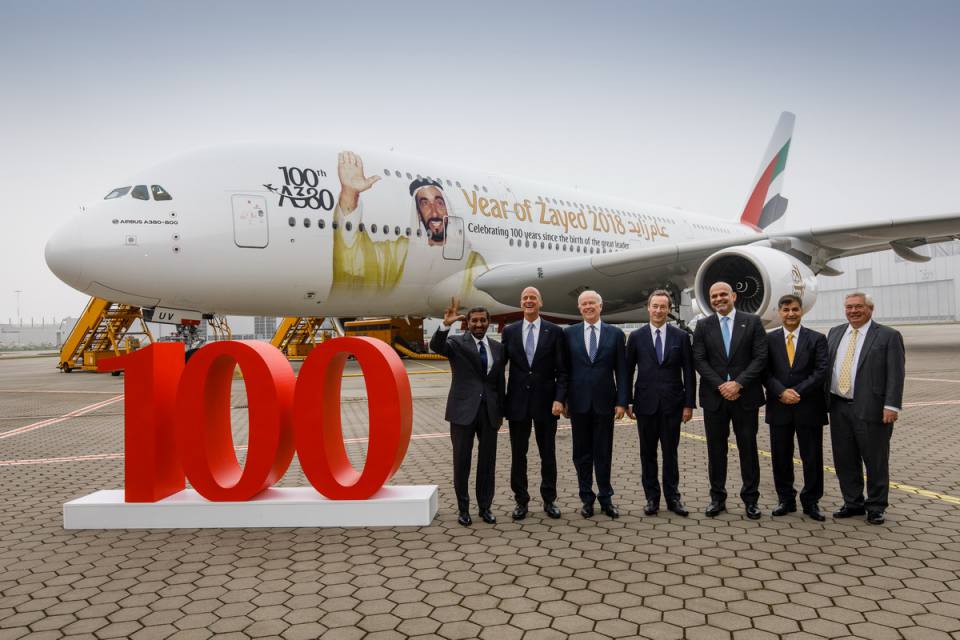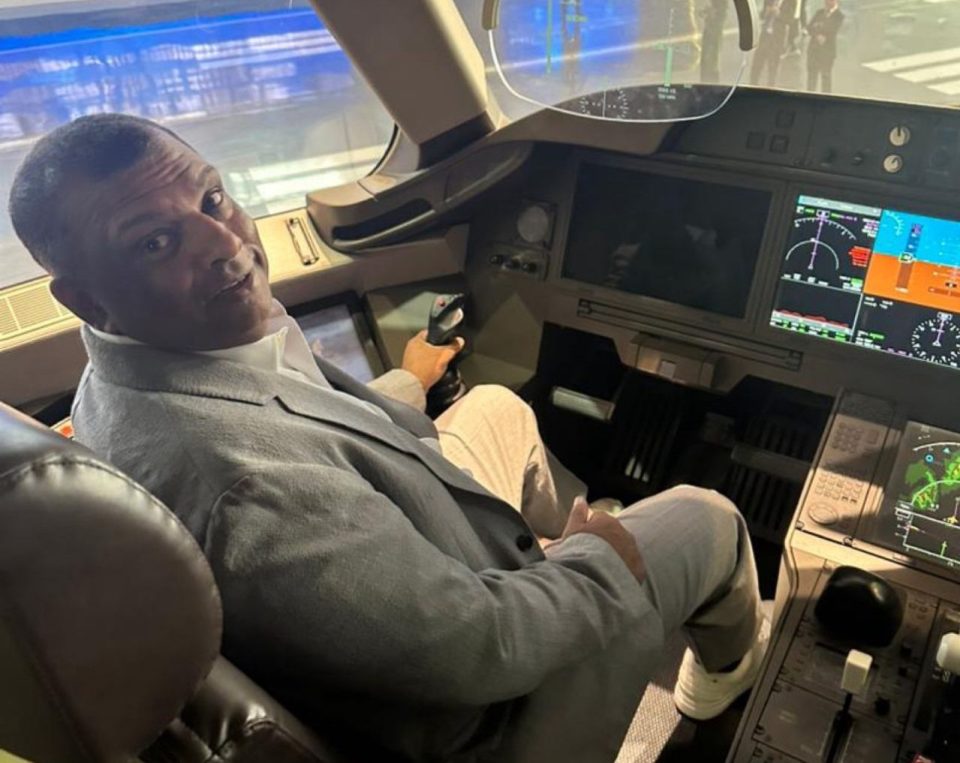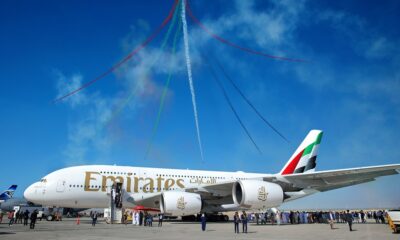Aerospace
Emirates welcomes 100th A380 to its fleet

- Celebrates milestone delivery in Hamburg, reaffirms commitment to A380 programme
- Emirates chairman highlights positive impact of Emirates’ A380 operations on aerospace manufacturing, aviation industries and consumer experience
DUBAI, U.A.E., 3 November 2017 – Emirates today celebrates the milestone delivery of its 100th Airbus A380 aircraft at a special ceremony with Airbus at the manufacturer’s delivery centre in Hamburg.

His Highness Sheikh Ahmed bin Saeed Al-Maktoum, Emirates’ Chairman and Chief Executive officiated the ceremony. He was joined at the event by Sir Tim Clark, President Emirates Airline; Tom Enders, Airbus Chief Executive Officer; Dominic Horwood, Rolls-Royce, Director – Customer and Services; His Excellency Ali Al Ahmed, UAE Ambassador to Germany and Frank Horch, Senator for Economy, Transport and Innovation of the Free and Hanseatic City of Hamburg.

Sheikh Ahmed said: “This is a tremendous moment for Emirates, for Airbus and for our many partners involved in the A380 programme. There is no doubt that the A380 has had a big positive impact on aerospace manufacturing and the broader aviation industry, supporting hundreds of thousands of jobs and stimulating innovation and new product development in many related areas such as ground handling, catering, airport facilities and cabin products, to name a few.
“Importantly, the A380 also brought the flying experience for our customers to the next level. The aircraft itself is a showpiece of engineering. It is the world’s largest commercial passenger jet but it is quiet and efficient and at Emirates we’ve utilised the onboard real estate to redefine the thinking around inflight products and experience. Our flight crew love to fly it and our customers love to fly in it.
“For Emirates, the A380 has been a success. We’ve been able to utilise it at slot-constrained airports, as well as at regional and ‘secondary’ airports where we have grown passenger demand. Each time we deploy an A380 onto a route, it typically stimulates further traffic and demand as travellers are attracted by our flagship A380 experience. We remain committed to the programme and will work closely with Airbus and our partners to continually enhance our A380 product as we look ahead to receiving our remaining 42 aircraft on order.”
“We are extremely proud of our long-standing relationship with Emirates – a partnership that has been integral to the A380 programme,” said Tom Enders. “It is a source of immense satisfaction for everyone at Airbus that such a visionary airline has believed in the A380 from the beginning and chosen it as its flagship and the backbone of its operations. And, of course, it is always exciting to hear positive feedback from our customers and passengers about the aircraft, while associating it with Dubai’s success as the world’s most dynamic air transport hub.”
Dominic Horwood said: “We would like to congratulate Emirates on this momentous occasion. We are very proud to be powering their 100th Airbus A380 and look forward to building on our strong relationship in years to come.”
Powered by Rolls-Royce engines, Emirates’ 100th A380 is configured in three cabin classes, with 14 private suites in First class, 76 seats in Business and 426 seats in Economy. It also features the airline’s newly revamped Onboard Lounge. It will be on display at the upcoming Dubai Air Show and will enter service afterwards.

Aerospace
India is set to build a central command for the Air Traffic Control system, called ISHAN

India’s air traffic growth has led to increased responsibilities for air traffic control. The Airports Authority of India (AAI) is considering centralizing air traffic control for aircraft, dividing the country into four regions. The goal is to consolidate India’s segmented airspace into a single entity to improve air traffic management (ATM) efficiency, safety, and smoothness.
Recently, the AAI invited expressions of interest to develop a detailed project report for the Indian Single Sky Harmonized Air Traffic Management (ISHAN) initiative in Nagpur. Under this plan, air traffic controllers in Nagpur would handle domestic flights flying above 25,000 feet, eliminating the need for coordination among controllers in different regions.
For domestic regional flights operating above 25,000 feet, control would shift to the central command in Nagpur. This consolidation aims to enhance airline operations, increase flight handling capacity, and reduce congestion and flight times for passengers.
Currently, the AAI provides ATM services over Indian airspace and adjoining oceanic areas, covering over 2.8 million square nautical miles. This airspace is divided into four flight information regions (FIRs) in Delhi, Mumbai, Kolkata, and Chennai, along with a sub-FIR in Guwahati.
FIRs are responsible for providing air traffic services, including weather information, visibility, and search and rescue assistance. The proposed unification under the ISHAN initiative aligns with the projected growth of the aviation industry, which anticipates a doubling of domestic passenger traffic by 2030.
Aerospace
Does AirAsia show interest in Comac aircraft in the future?

Tony Fernandes, CEO of Capital A, operating as AirAsia Group, recently paid a visit to the facilities of COMAC on April 2, 2024, and was thoroughly impressed by what he witnessed.
C919 already securing nearly 1000 orders
COMAC, known for its homegrown aircraft, has launched two promising jets: the ARJ21 and the C919 aircraft. Both aircraft are gaining popularity in the Chinese market, with the C919 already securing nearly 1000 orders from various airlines.
Fernandes expressed his admiration for COMAC’s achievements in aircraft manufacturing, acknowledging the immense challenge it entails. His visit underscored the realization that AirAsia now has a viable third option when it comes to selecting aircraft for its fleet.
During his tour, Fernandes was delighted by the innovation and technology evident in COMAC’s aircraft production and the company’s commitment to long-term partnerships.
He noted that many Western companies have shifted away from prioritizing loyalty and customer service, opting instead for short-term gains and a narrow definition of success.
Last month, COMAC embarked on an international tour, showcasing demonstration flights to neighboring countries, particularly Indonesia and Malaysia. Fernandes believes that the positive impression left by COMAC during his visit opens up new opportunities for collaboration.
Fernandes emphasized COMAC’s remarkable achievements
The shared values of loyalty, customer service, and long-term vision align closely with AirAsia’s ethos, making collaboration with COMAC appealing. With a focus on innovation and excellence, both companies stand to benefit from a partnership grounded in trust and a shared commitment to success.
Indonesia and China have already collaborated in validating and maintaining the airworthiness of the ARJ21 aircraft, indicating a solid foundation for future partnerships.
In his statement, Fernandes emphasized COMAC’s remarkable achievements and genuine desire for long-term partnership, highlighting the absence of ego and a genuine willingness to succeed together. He marveled at COMAC’s fully automated, AI-driven factory, a testament to their dedication to innovation and efficiency.
Fernandes criticized Western firms for prioritizing short-term gains over loyalty, customer service, and long-term strategy, emphasizing the importance of understanding customers’ needs and collaborating to achieve success.
Aerospace
Indigo will soon launch Air Taxi Service in India

InterGlobe Enterprises, the parent brand of IndiGo, is set to revolutionize travel in India with its upcoming air taxi service.
Scheduled for a potential launch in 2026, this innovative venture promises a seamless journey for passengers between two bustling hubs. Delhi and Gurgaon in Haryana. The forthcoming service is projected to revolutionize the daily commute, offering passengers a swift aerial journey covering the distance in a mere 7 minutes.
This remarkable efficiency contrasts starkly with the conventional 90-minute drive, underscoring the immense time-saving potential for commuters. The anticipated fare, ranging from Rs 2,000-3,000, makes this innovative mode of transport not only swift but also remarkably competitive in pricing.
At the heart of this ambitious endeavor lies a strategic partnership with Archer Aviation, a pioneer in electric vertical takeoff and landing (eVTOL) aircraft technology. Under this collaboration, Archer will supply 200 state-of-the-art eVTOL aircraft, representing an investment of US$ 1 billion. These cutting-edge aircraft, capable of accommodating up to four passengers alongside the pilot, epitomize the future of sustainable air travel.
Powered by six battery packs, Archer’s eVTOL aircraft boast rapid charging capabilities, enabling a swift turnaround between flights. With a charging time of just 30-40 minutes, these eco-friendly aircraft ensure minimal downtime, maximizing operational efficiency.
Similar services are anticipated to be introduced by the joint venture in Bengaluru and Mumbai as well. Nevertheless, the service rollout period has not yet been made public by the company. Next year, it is anticipated to get its certification. Following this, the company will start the certification procedure with the Directorate General of Civil Aviation (DGCA).





























